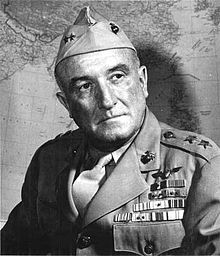
Summary
Francis Patrick Mulcahy CBE (March 9, 1894 – December 11, 1973) was a general and commander in the United States Marine Corps during World War II. Mulcahy commanded the 2nd Marine Aircraft Wing, the Cactus Air Force, and the Tactical Air Force, Tenth Army.
Francis Patrick Mulcahy | |
|---|---|
 Major General Francis P. Mulcahy | |
| Born | March 9, 1894 Rochester, New York, US |
| Died | December 11, 1973 (aged 79) |
| Allegiance | |
| Service/ | |
| Years of service | 1917–1946 |
| Rank | |
| Service number | 0-695 |
| Commands held | 2nd Marine Aircraft Wing Allied Air Forces in the Solomons (Cactus Air Force), Tactical Air Force, Tenth Army |
| Battles/wars | World War I World War II |
| Awards | Navy Distinguished Service Medal (2) Army Distinguished Service Medal Legion of Merit |
Military career edit
Mulcahy, a native of Rochester, New York, graduated from Notre Dame University in 1914. In 1917, he was commissioned and attended naval flight school, becoming a naval aviator.[1] Like Roy S. Geiger, Mulcahy flew bombing missions in France during World War I. He became one of the Marine Corps pioneers of close air support to ground operations during the inter-war years of expeditionary campaigns in the Caribbean and Central America.[1]
At the time of the Japanese attack on Pearl Harbor, Mulcahy was serving as an observer with the British Western Desert Air Force in North Africa. He deployed to the Pacific in command of the 2nd Marine Aircraft Wing.[1] In the closing months of the Guadalcanal campaign, Mulcahy served in command of Allied Air Forces in the Solomon Islands, also known as the Cactus Air Force.
In August 1943, Mulcahy moved from Guadalcanal to New Georgia to command air units operating out of the newly captured airfield at Munda Point.[2]
In September 1944, Mulcahy succeeded Major General Ross E. Rowell, USMC, as the commanding general of Aircraft, Fleet Marine Force.[3] He was also commanding general of the Marine Fleet Air, West Coast.
Mulcahy volunteered to lead the Tactical Air Force, Tenth Army during the Invasion of Okinawa.[4] He was deployed ashore early to the freshly captured air fields at Yontan and Kadena, and worked to coordinate the combat deployment of his joint-service aviators against the kamikaze threat to the fleet and in support of the Tenth Army in its protracted inland campaign. On June 11, 1945, he was relieved by Louis E. Woods because of poor health. Upon his retirement he was promoted to the rank of lieutenant general.[5]
He died on December 11, 1973.[6]
Awards edit
Mulcahy was the recipient of the following awards:
| Naval Aviator Badge | ||||||||||||||||
| 1st Row | Navy Distinguished Service Medal with Gold Star | Army Distinguished Service Medal | Legion of Merit | |||||||||||||
|---|---|---|---|---|---|---|---|---|---|---|---|---|---|---|---|---|
| 2nd Row | Navy Commendation Medal with Gold Star | Marine Corps Expeditionary Medal with two service stars | World War I Victory Medal with two battle clasps | Nicaraguan Campaign Medal (1933) | ||||||||||||
| 3rd Row | American Defense Service Medal with Foreign Service Clasp | European-African-Middle Eastern Campaign Medal | American Campaign Medal | Asiatic-Pacific Campaign Medal with two service stars | ||||||||||||
| 4th Row | World War II Victory Medal | Commander of the Order of the British Empire | Nicaraguan Cross of Valor | Nicaraguan Medal of Distinction and Diploma | ||||||||||||
See also edit
Notes edit
- ^ a b c Alexander, Colonel Joseph H., USMC (Ret) (1996). "Biographies: Senior Marine Commanders". The Final Campaign: Marines in the Victory on Okinawa. Marines in World War II Commemorative Series. Washington, D.C.: Marine Corps Historical Center, United States Marine Corps. Retrieved August 4, 2008.
{{cite book}}: CS1 maint: multiple names: authors list (link) - ^ Melson, p. 33.
- ^ "CINCPAC Press Release No. 559". September 18, 1944. Archived from the original on June 10, 2011. Retrieved September 1, 2008.
- ^ Alexander, Colonel Joseph H. (1996). "Countdown to 'Love-Day'". The Final Campaign: Marines in the Victory on Okinawa.
- ^ "Francis P. Mulcahy Papers". Hesburgh Library Archives, University of Notre Dame. Retrieved September 1, 2008.
- ^ Alexander, USMC, Ret., Colonel Joseph H. "The Final Campaign Marines in the Victory of Okinawa" (PDF). Official Website of the United States Marine Corps. p. 7. Retrieved January 23, 2020.
{{cite web}}: CS1 maint: multiple names: authors list (link)
References edit
- This article incorporates public domain material from websites or documents of the United States Marine Corps.
- Web
- Alexander, Colonel Joseph H., USMC (Ret) (1996). The Final Campaign: Marines in the Victory on Okinawa. Marines in World War II Commemorative Series. Washington, D.C.: Marine Corps Historical Center, United States Marine Corps. Retrieved July 30, 2008.
{{cite book}}: CS1 maint: multiple names: authors list (link)
- Frank, Benis M.; Henry I. Saw, Jr (1968). Volume V: Victory and Occupation. Historical Branch, United States Marine Corps. Retrieved July 30, 2008.
{{cite book}}:|work=ignored (help) - Johnson, Edward C. (1977). Marine Corps Aviation: The Early Years 1912–1940 (PDF). History and Museums Division, U.S. Marine Corps. Retrieved July 30, 2008.
- Melson, Charles D. (1993). "Up the Slot: Marines in the Central Solomons". World War II Commemorative Series. History and Museums Division, Headquarters, U.S. Marine Corps. p. 36. Retrieved September 26, 2006.
- Temple, L. Parker III (1988). "Of Autogyros and Dinosaurs". Airpower Journal. United States Air Force. Retrieved July 30, 2008.
- Willock, Roger (1968). Unaccustomed to Fear – A Biography of the Late General Roy S. Geiger. Marine Corps Association. ISBN 0-940328-05-4.
External links edit
Media related to Francis P. Mulcahy at Wikimedia Commons
- Arlington National Cemetery


